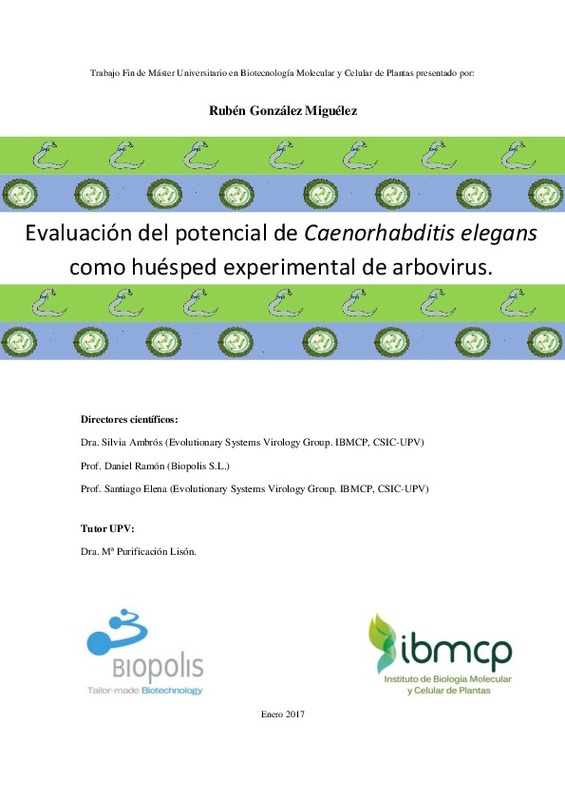JavaScript is disabled for your browser. Some features of this site may not work without it.
Buscar en RiuNet
Listar
Mi cuenta
Estadísticas
Ayuda RiuNet
Admin. UPV
Evaluación del potencial de Caenorhabditis elegans como huésped experimental de arbovirus
Mostrar el registro sencillo del ítem
Ficheros en el ítem
| dc.contributor.advisor | Elena Fito, Santiago Fco
|
es_ES |
| dc.contributor.advisor | Ramon Vidal, Daniel
|
es_ES |
| dc.contributor.advisor | Lisón Párraga, María Purificación
|
es_ES |
| dc.contributor.advisor | Ambros Palaguerri, Silvia
|
es_ES |
| dc.contributor.author | González Miguélez, Rubén
|
es_ES |
| dc.date.accessioned | 2017-02-08T06:54:18Z | |
| dc.date.available | 2017-02-08T06:54:18Z | |
| dc.date.created | 2017-01-23 | |
| dc.date.issued | 2017-02-08 | es_ES |
| dc.identifier.uri | http://hdl.handle.net/10251/77745 | |
| dc.description.abstract | [EN] So far, Caenorhabditis elegans has been used as model organism in many different fields of study, but seldom used as experimental host in virology studies. The present work seeks to evaluate the potential of the nematode to support the replication of the thrip-transmitted plant ambisense ssRNA virus Tomato spotted wilt virus (TWSV; genus Tospovirus, family Bunyaviridae). The choice of this phytopathogenic virus is due to its ability to persistently replicate inside its thrips vector. In order to test TSWV infectivity, several strains of C. elegans were inoculated with plant extracts infected with the strain PVR of the virus. Along with the wild type nematode strain N2, which is commonly used in the laboratory, the JU1580 and RB2519 strains were also evaluated. These two strains are deficient in the RNA interference (RNAi) machinery, which plays an essential role in the antiviral response of the worm. A reduction in lifespan and an increase in mortality were observed in worms treated with virus-containing plant extracts in comparison with worms treated with extracts from healthy plants, suggesting that TSWV might replicate inside the nematode with a concomitant virulence. This effect is stronger in RNAi-deficient strains JU1580 and RB2519 than in wild type N2. To confirm this point, an qRT-PCR protocol is being optimized and applied. The capacity of TSWV successfully infecting C. elegans opens a wide range of possibilities for the study of host-virus interactions: (i) from the evolution of host-range in RNA viruses, to (ii) the establishment of the molecular mechanisms driving this novel hostvirus interaction and to (iii) the interplay between viral infection and cell differentiation and organismal development, among many others | es_ES |
| dc.description.abstract | El objetivo de este estudio es analizar y comprender la interacción entre virus de plantas, sus huéspedes vegetales y sus vectores artrópodos; en particular para virus que incorporan una fase de replicación en el vector y que desde un punto de vista ecológico presentan la gama de huéspedes más amplia descrita hasta la fecha: plantas y animales. Para ello, se estudiará el potencial de replicación del arbovirus fitopatógeno Tomato spotted wilt virus (TSWV; género Tospovirus, familia Bunyaviridae), un virus con genoma tripartito de ssRNA de polaridad negativa, en el huésped experimental Caenorhabditis elegans. Se testarán y optimizarán diversas condiciones experimentales en las que TSWV pueda potencialmente ser capaz de infectar al nematodo: modificando el grado de purificación del inóculo viral de partida, los tiempos de incubación (adquisición) con el nematodo, la extracción de RNA toral de éste y la puesta a punto de un método sensible y específico para detectar en el mismo el RNA viral mediante RT-PCR cuantitativa. Además, se utilizarán distintas cepas de Caenorhabditis elegans mutantes en la ruta de defensa mediada por el RNA de interferencia (RNAi), que pudieran resultar más susceptibles a la infección viral en comparación con la cepa salvaje que se considera un genotipo más resistente. En caso de obtener infección en alguna de las condiciones reseñadas, procederíamos a realizar un experimento de evolución mediante pases seriados de 10 linajes independientes del virus en su nuevo huésped. Este tipo de ensayo permitiría determinar si alguna propiedad virológica (infectividad específica, carga viral y virulencia) cambia en el nuevo huésped. | es_ES |
| dc.language | Español | es_ES |
| dc.publisher | Universitat Politècnica de València | es_ES |
| dc.rights | Reserva de todos los derechos | es_ES |
| dc.subject | Arbovirus; Caenorhabditis elegans; Fitopatógeno; Gama de huéspedes; Tomato spotted wilt virus | es_ES |
| dc.subject.classification | BIOQUIMICA Y BIOLOGIA MOLECULAR | es_ES |
| dc.subject.other | Máster Universitario en Biotecnología Molecular y Celular de Plantas-Màster Universitari en Biotecnologia Molecular i Cel·Lular de Plantes | es_ES |
| dc.title | Evaluación del potencial de Caenorhabditis elegans como huésped experimental de arbovirus | es_ES |
| dc.type | Tesis de máster | es_ES |
| dc.rights.accessRights | Abierto | es_ES |
| dc.contributor.affiliation | Universitat Politècnica de València. Departamento de Biotecnología - Departament de Biotecnologia | es_ES |
| dc.description.bibliographicCitation | González Miguélez, R. (2017). Evaluación del potencial de Caenorhabditis elegans como huésped experimental de arbovirus. http://hdl.handle.net/10251/77745 | es_ES |
| dc.description.accrualMethod | TFGM | es_ES |
| dc.relation.pasarela | TFGM\61505 | es_ES |






